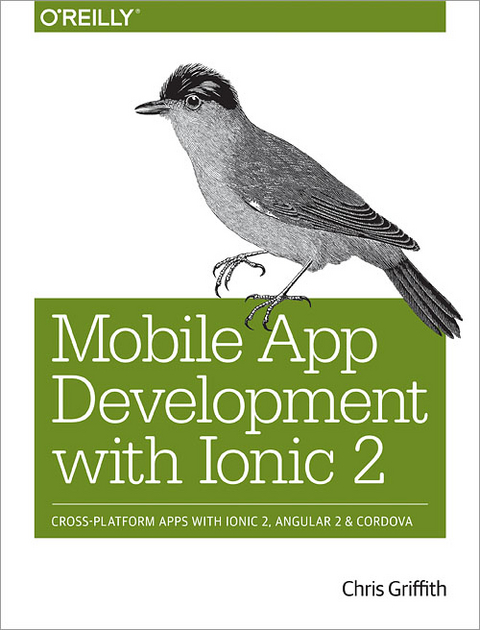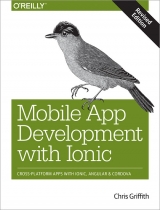
Mobile App Development with Ionic 2
O'Reilly Media (Verlag)
978-1-4919-3778-5 (ISBN)
- Titel ist leider vergriffen;
keine Neuauflage - Artikel merken
Learn how to build app store-ready hybrid apps with the Ionic 2, the framework built on top of Apache Cordova (formerly PhoneGap) and Angular. This practical guide shows you how to use Ionic’s tools and services to develop apps with HTML, CSS, and TypeScript, rather than rely on platform-specific solutions found in Android, iOS, and Windows Phone.
Author Chris Griffith takes you step-by-step through Ionic’s powerful collection of UI components, and then helps you use it to build three cross-platform mobile apps. Whether you’re new to this framework or have been working with Ionic 1, this book is ideal for beginning, intermediate, and advanced web developers.
- Understand what a hybrid mobile app is, and what comprises a basic Ionic application
- Learn how Ionic leverages Apache Cordova, Angular, and TypeScript to create native mobile applications
- Create a Firebase-enabled to-do application that stores data across multiple clients
- Build a tab-based National Park explorer app with Google Map integration
- Develop a weather app with the Darksky weather API and Google’s GeoCode API
- Debug and test your app to resolve issues that arise during development
- Walk through steps for deploying your app to native app stores
- Learn how Ionic can be used to create Progressive Web Apps
Chris Griffith is a staff engineer in the User Experience group at Qualcomm and an author for lynda.com. He is also an instructor at the University of California, San Diego Extension, teaching mobile application development, and an Adobe Community Professional. Chris is regularly invited to speak at conferences such as Adobe MAX and HTML5DevConf. He has developed several iPhone and Android applications. In addition, he has served as a technical reviewer for several publications, and written for uxmag.com. He also has created ConfiGAP, a utility for Adobe PhoneGap Build developers and developed several code hinting modules for the Brackets code editor. In his spare time, Chris spends time with his family, sea kayaking, hiking and craft beer.
Chapter 1Hybrid Mobile Apps
What Is the Ionic Framework?
What’s New in Ionic 2?
Comparing Mobile Solutions
Understanding the Ionic Stack
Prerequisites for Ionic Application Development
Summary
Chapter 2Setting Up Our Development Environment
Installing the Ionic Framework
Starting a New Ionic Project
Platform Tools Installations
Setting Emulators
Setting Up Your Devices
Adding Mobile Platforms
Previewing on Emulator
Previewing on Device
Summary
Chapter 3Understanding the Ionic Command-Line Interface
Define Your Build Platforms
Managing Cordova Plugins
Ionic Generator
Previewing Your Application
The Ionic lab Command
Specifying an IP Address to Use
Emulating Your Ionic App
Running Ionic App on a Device
Logging
CLI information
Summary
Chapter 4Just Enough Angular and TypeScript
Why Angular 2?
Understanding ES6 and TypeScript
Summary
Chapter 5Apache Cordova Basics
The History of Cordova (aka PhoneGap)
Apache Cordova versus Adobe PhoneGap
A Deep Dive into Cordova
Configuring Your Cordova App
Device Access (aka Plugins)
Interface Components: The Missing Piece
Why Not Cordova?
Understanding Web Standards
Summary
Chapter 6Understanding Ionic
HTML Structure
Ionic Components
Understanding the SCSS File
Understanding TypeScript
Summary
Chapter 7Building Our Ionic2Do App
Adding our Platforms
Previewing Our Ionic2Do App
Updating the Page Structure
Adding Full-Swipe Gesture
Simple Theming
Proper Typing
Saving Data
Creating a FireBase account
Installing Firebase and AngularFire2
Ionic Build System
Adding AngularFire to Our app.module.ts File
Using Firebase Data
Using Ionic Native
Summary
Chapter 8Building a Tab-Based App
Bootstrapping Our App
Loading Data via the HTTP Service
Display our Data
Generating New Pages
Understanding the Ionic 2 Navigation model
Updating the Park Details Page
Add a Google Map
Rendering the Google Map
Add Map Markers
Adding Search
Theming Our Application
Virtual Scrolling
Custom List Headers
Summary
Chapter 9Building a Weather Application
Getting Started
Exploring the Side Menu Template
Side Menu Options
Displaying the Menu
Converting the Template
Mocking Up Our Weather Provider
Laying Out the Weather Data
Loading Feedback: Loading Dialogs and Pull to Refresh
Adding GeoLocation
Accessing Live Weather Data
Connecting the Geolocation and Weather Providers
Getting Other Locations’ Weather
Pull to Refresh: Part 2
Editing the Locations
Using a Geocoding Service
Dynamically Updating the Side Menu
Ionic Events
Observables
Styling the App
Add a Weather Icon
Next Steps
Summary
Chapter 10Debugging and Testing Your Ionic Application
Dealing with CORS Issues
Debugging through an iOS or Android Simulator
Debugging On-Device
Debugging Ionic Initialization
Additional Tools
Summary
Chapter 11Deploying Your Application
Adjusting the config.xml File
App Icons and Splash Screens
Building Your Android APK
Building Your iOS App
Summary
Chapter 12Exploring the Ionic Cloud
Setting Up Ionic Cloud
Generating Your Ionic App ID
Configuring Your Application
Ionic Deploy
Security Profiles
Ionic Package
Ionic View
Ionic Creator
Summary
Chapter 13Progressive Web Apps
But What, Exactly, Is a Progressive Web App?
The manifest.json File
Service Workers
Push Notifications
What’s Next?
Chapter 14Conclusion
Components You Should Know About
Next Steps
Ionic Forums
Conclusion
Appendix Migrating Ionic 1 to Ionic 2
Create a New Ionic 2 Application
Switching to Ionic Native
Conclusion
Appendix Understanding the Config.xml File
Essential Properties
Preferences
Icons
Splashscreens
Plugins
Features
Reference
Appendix Ionic Component Library
| Erscheinungsdatum | 28.04.2017 |
|---|---|
| Verlagsort | Sebastopol |
| Sprache | englisch |
| Maße | 181 x 233 mm |
| Gewicht | 514 g |
| Einbandart | kartoniert |
| Themenwelt | Mathematik / Informatik ► Informatik ► Theorie / Studium |
| Informatik ► Web / Internet ► HTML / CSS | |
| Informatik ► Weitere Themen ► Smartphones / Tablets | |
| Schlagworte | App-Entwicklung • hybride Apps, App-Programmierung, PhoneGap, Cordova, Web-Apps • ionic • Webentwicklung |
| ISBN-10 | 1-4919-3778-5 / 1491937785 |
| ISBN-13 | 978-1-4919-3778-5 / 9781491937785 |
| Zustand | Neuware |
| Informationen gemäß Produktsicherheitsverordnung (GPSR) | |
| Haben Sie eine Frage zum Produkt? |
aus dem Bereich



